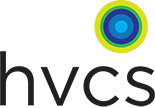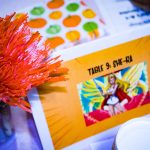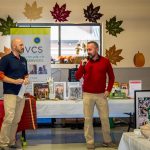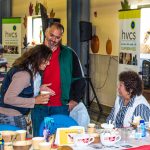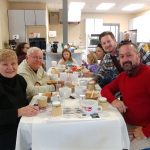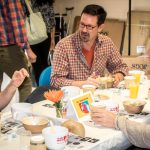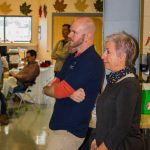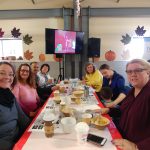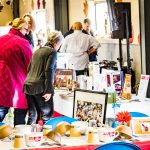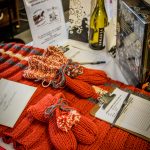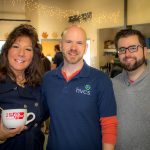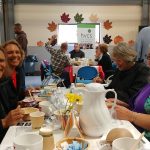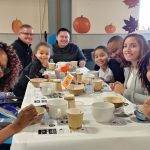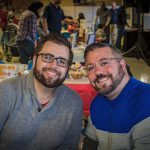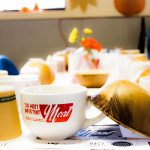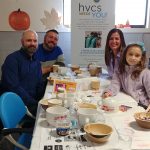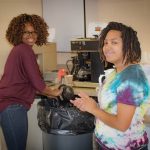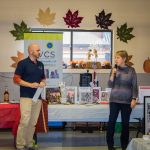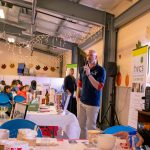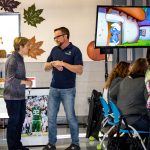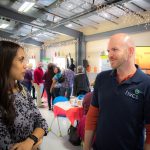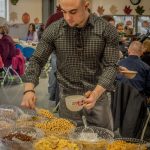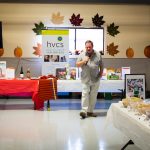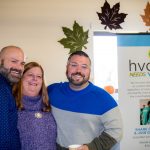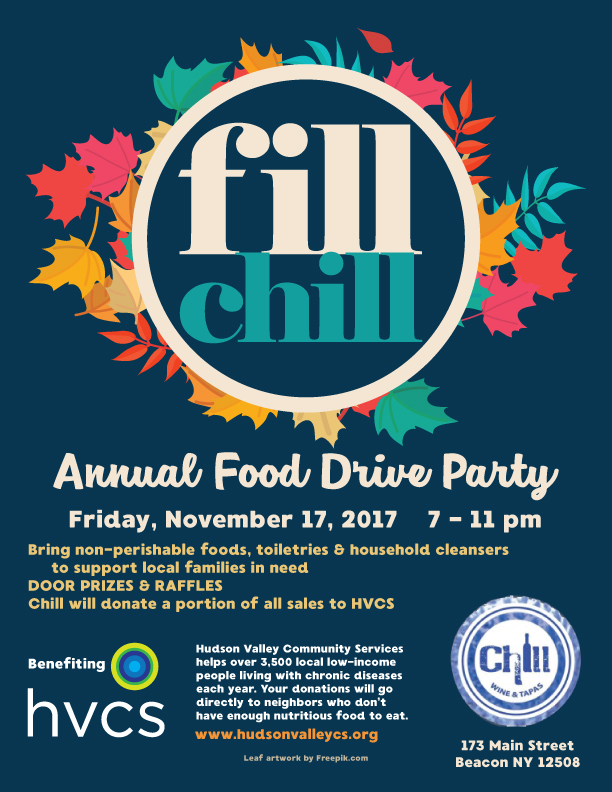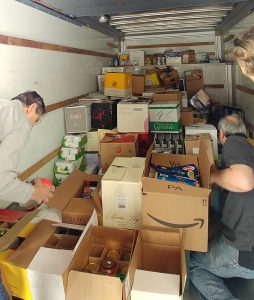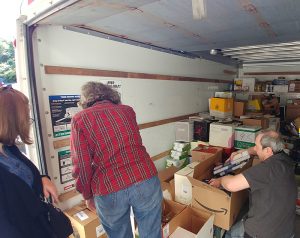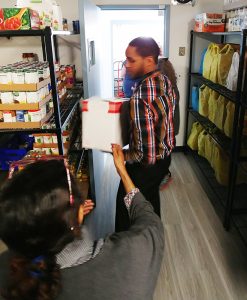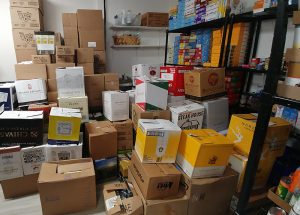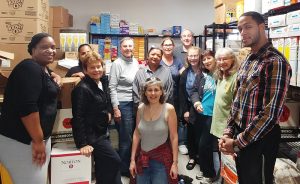Thanks to everyone who made our new fundraising event, The Most Important Meal, a success! Photos by Anthony Accomando and Ryan Judge.
Posts Tagged ‘donations’
Photos From The Most Important Meal
Monday, November 6th, 2017Fill Chill Annual Food Drive Party
Tuesday, October 3rd, 2017Plus, John Martin from Superior Sounds will be DJing!
Chill Wine Bar is located at 173 Main St., Beacon NY 12508.
Leaf circle artwork courtesy of www.freepik.com.
Woodlands Community Temple Organizes Food Drive for HVCS
Monday, October 2nd, 2017Woodlands Community Temple in Greenburgh, NY organized a food drive for HVCS’ emergency food closets on Sunday, October 1st. Thanks to everyone who donated and the volunteers who brought a delivery truck full of food to our Hawthorne office!
- The congregation collected enough food to fill a delivery truck.
- Unpacking the delivery truck at HVCS’ Hawthorne food pantry.
- Naomi and Cris, from our THRIVES team, help unload and sort boxes of donated food.
- Woodlands’ food drive results fill our food pantry.
- Woodlands Community Temple congregation members pose with HVCS’ THRIVES Nutrition program staffers.
The Most Important Meal
Friday, September 22nd, 2017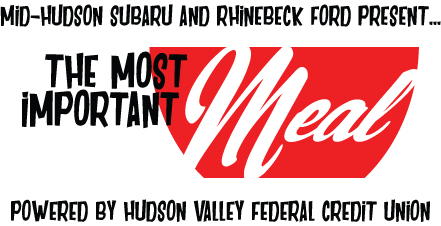 Help local people who are living with chronic illnesses get the nutrition and support they need to stay as healthy as possible!
Help local people who are living with chronic illnesses get the nutrition and support they need to stay as healthy as possible!
Join HVCS, Mid-Hudson Subaru, Rhinebeck Ford and Hudson Valley Federal Credit Union at the Fishkill Recreation Center on Saturday, November 4, 2017 from 9:30 am to 12 noon for a fun-filled breakfast blast from the past. Every ticket includes a commemorative souvenir bowl so you’ll always remember that the most important meal is the one you made possible for someone without enough food.
Fill up your bowl at the all-you-can-eat cereal and granola buffet including fun mix-ins, fruit, a variety of Hudson Valley Fresh milks and Dannon yogurt (gluten-free and vegan options will be available, too). You’ll also get bottomless coffee, tea and juice served by your table host. Watch some of your favorite Saturday morning cartoons and bid on fantastic silent auction items–all while raising funds for HVCS’ food and nutrition programs.
Our food and nutrition programs serve hundreds of people and families each year, but their government contracts can’t fully support them, or they rely entirely on support from caring people like you.
Can’t make it on November 4th, or want to make a donation to honor someone else! Send a Cereal-Gram! For a $50 donation, we’ll send you or someone you love a commemorative bowl with a mini box of cereal and boxed milk. Plus, your Cereal-Gram will feed a family for a week!
Get tickets via Eventbrite or visit our Facebook page!
New Online Donation Methods to Support HVCS
Thursday, September 21st, 2017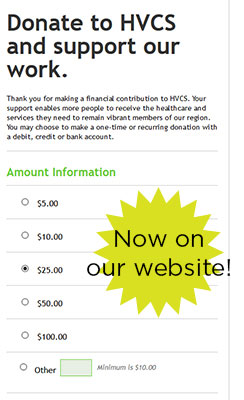 According to a recent survey of our supporters, 69% say they prefer to donate to HVCS online. We’ve responded by upgrading our website’s Donate page and by adding a new way to easily donate on Facebook.
According to a recent survey of our supporters, 69% say they prefer to donate to HVCS online. We’ve responded by upgrading our website’s Donate page and by adding a new way to easily donate on Facebook.
Now when you visit our Donate page, you’ll find a more robust online donation box where you can securely make a contribution to us, without jumping to another website or needing to enter any log-in info. And, for the first time, you can set up a recurring contribution–weekly, monthly or quarterly! A recurring donation is an easy, stress-free way to show your support for HVCS’ work throughout the Hudson Valley. (Plus, 10% of you said you’d like to make monthly donations to us.)
We’ve also been verified to receive donations directly through our Facebook page–just click on the Donate button at the top of our page. You can also easily set up your own fundraiser for us and collect donations for HVCS from your online friends. Kudos to volunteer Matt for turning his birthday into a fundraiser for us!
If you have any questions about these new methods, please contact us–we’re here to help!
Hudson Valley Dance Festival
Tuesday, August 8th, 2017Renowned dance companies and emerging artists return to the heart of the Hudson Valley when Hudson Valley Dance Festival presents its fifth annual edition with performances at 2 pm and 5 pm October 7. The festival will again transform the 115-year-old wooden warehouse at Historic Catskill Point into a modern-day dance venue.
In its first four years, Hudson Valley Dance Festival has raised an impressive $460,397. The money raised helps Dancers Responding to AIDS and Broadway Cares/Equity Fights AIDS provide grants to AIDS and family service organizations nationwide, including nine based in the Hudson Valley, including HVCS. (In fact, Broadway Cares/Equity Fights AIDS just gave us at $10,000 grant to support our Client Assistance Program!)
Tickets start at $40 and are on sale now. Sponsorship opportunities also are available. The VIP reception will take place at W&G SPACE in Catskill, a beautifully renovated art studio on Catskill Creek. New this year is a special VIP daytrip package from New York City that includes roundtrip luxury bus transportation, a tour of the just-restored Thomas Cole National Historic Site with champagne luncheon, a ticket to the 2 pm performance and a cocktail reception after the show. In the 1800s, Cole was the founder of the famed Hudson River School of painting, the nation’s first art movement, and the inspiration for this year’s Hudson Valley Dance Festival artwork.
Homegrown Fundraisers: You Can Be a Fundraising Superstar for HVCS!
Thursday, July 27th, 2017We’re sharing this article from The Chronicle of Philanthropy’s May issue because it’s in sync with a new initiative we’re starting here at HVCS. We’re encouraging our supporters to try their hand at a third-party fundraiser–which really means a small, personal fundraising event that you throw or do for your circle of friends and family. A third-party event can be a fantastic way to help HVCS’ clients without a ton of planning, worrying and overhead. From holding a potluck supper in your home to booking a paint-and-sip charity night to going on a hike, you can turn any event into a fundraiser with a little ingenuity. Check out our new guide to third-party events, and read on for more ideas.
Weddings. Birthday parties. Bike rides. Bake sales. Pub crawls.
More groups than ever are offering online tools to help supporters raise money through a widening variety of events, activities, or challenges that they conceive, organize, and manage themselves.
Paragliding all over the world? Why not raise money while you do it?
Giving up drinking for a month? Let’s set up a fundraising page for that.
The online tools make it easy for people to create their own pages and share them on social media or through email — creating new groups of supporters for nonprofits in the process.
Charities say they are facilitating these fundraising options to keep up with supporters’ shifting habits. Platforms like GoFundMe allow people to raise money in almost any way they want to, and nonprofits say they need to be just as flexible.
New platforms like DonorDrive and Blackbaud’s Everydayhero have allowed charities large and small to register these do-it-yourself events at low cost. For example, Everydayhero is free for nonprofits that use Blackbaud’s TeamRaiser software — which helps people raise money for charity through events organized by nonprofits — and about $1,000 for those that don’t. There’s also an administrative fee, usually around 5 percent, per transaction.
While the amounts raised usually are only a sliver of most charities’ overall contributions, grass-roots fundraising events offer big potential for acquiring new supporters. Their promise is limited only by nonprofits’ willingness and ability to help.
“It’s an emerging trend, fueled by technology and changes in how people communicate and run their lives in the digital age,” says David Hessekiel, president of the Peer-to-Peer Professional Forum, which provides resources for nonprofits that run events in which supporters raise money on behalf of nonprofit organizations.

Fast-Growing Trend
Just a decade ago, most nonprofits were cautious about liability issues related to outside supporters using logos and marketing materials in ways that might embarrass the organization, says Mr. Hessekiel.
Trailblazers included the St. Baldrick’s Foundation, which put on head-shaving events to support children’s cancer research, and Movember, which urges men to grow mustaches to raise funds for male health efforts. The St. Baldrick’s events raised $34.9 million in 2016, and Movember raised $17.2 million.
Those organizations were soon joined by other nonprofits big enough to have the staff and expertise to promote and oversee DIY events.
“For bigger charities, it’s pretty much expected now,” says Kevin Scally, director of digital marketing for Smile Train, which launched a donor platform last November with new features for its DIY fundraisers.
The technology boom has allowed smaller players to join the action in recent years using an expanding and diverse array of low-cost tools. However, the money from homegrown fundraisers doesn’t come free or without effort: Many groups devote significant staff time and marketing dollars to help supporters with their campaigns.
“There’s been a lot of disappointment” for groups that think DIY events generate easy money, says Mr. Hessekiel.
Attracting Younger Donors
Smile Train, a group that instructs doctors in how to help children in poor countries who need surgery to correct cleft lip, allows supporters to build profiles on its website that resemble social-network pages. Through the profiles, supporters can start their own fundraising campaigns and add a video, photos, and a description of their event. They can also comment on other people’s pages and share their fundraising events on Facebook, Twitter, and other social-media sites.
If the grass-roots event gets offline contributions, those can be logged into the online system to show gratitude to the donor.
So far, DIY fundraisers make up only a small percentage of the organization’s support. But Mr. Scally says it’s still vital to provide a way for Smile Train to accommodate anyone who wants to raise money. The organization hopes its DIY program will attract younger donors, he says. It seems to be doing just that; 48 percent of Smile Train’s DIY organizers are millennials, and 33 percent are from Generation X.
On the charity’s website, people can choose from a range of options, like athletic events or birthday celebrations in which guests are asked to give to Smile Train. They can also select the “get creative” option and come up with their own idea.
“It’s really important in today’s day and age to have a set of tools where people can go on and create things on their own,” Mr. Scally says. “You know how easy it is to set up a GoFundMe page. You know how easy it is to set up a Facebook profile. We tailor our tools to be similar to that type of sign-up process — where it’s quick, it’s easy, it’s fun.”
Among its DIY events posted online:
- Last year, a couple from Edison, N.J., raised $1,725 during a housewarming party.
- A yoga instructor in West End, N.C., donated $6,100 — a percentage of revenue from her class — to Smile Train.
- A couple from Saratoga Springs, N.Y., has committed to raise money every year until their infant son, who has a cleft lip, turns 18. Their goal: $175,000.
Banners and Balloons
Some organizations are asking supporters to start DIY events as part of larger campaigns.
The Alzheimer’s Association, for instance, asks people to organize their own events for its “Longest Day” campaign. Many of the events are held on the summer solstice, although people can raise money year-round. The campaigns run the gamut: rides, hikes, climbs, bowling, golfing, bridge tournaments. On June 20 last year, a supporter wrote poems on his blog from sunrise to sunset in honor of his wife, who suffers from Alzheimer’s. He raised a little more than $400.
Longest Day events raised almost $4 million in 2016 — the second-biggest peer-to-peer fundraising campaign for the nonprofit after its signature Walk to End Alzheimer’s. Longest Day is expected to raise even more this year, says Donna McCullough, the charity’s chief development officer.
Part of the reason for the campaign’s success, she says, is that supporters can access items like banners, balloons, and cups with the campaign’s logo to use in their events. The drive’s Facebook page is littered with people wearing “Longest Day” T-shirts at their individual events.
“It unites them in a common goal, and it really gives them a sense of joining the Alzheimer’s movement,” Ms. McCullough says.
Tips and Webinars
Many groups that have a DIY program provide tips and other resources for people raising money.
Water Mission, for instance, gives a DIY-fundraising tool kit to campaigns with goals of raising between $10,000 and $30,000. The clean-water charity’s kit includes customizable posters and fliers, a news-release template, and a fundraising tip sheet.
For World Vision’s Global 6K for Water drive, to be held May 6, the aid charity held regular webinars to educate people on the cause and talk about challenges and advice for hosting a six-kilometer walk on behalf of the organization. The webinars helped “create a sense of community early on,” says John Overy, director of digital marketing for World Vision, by making supporters feel like they were part of a large campaign.
Tending the Grass Roots
Many nonprofits have failed to provide enough help to DIY fundraisers to take full advantage of what they have to offer, experts say. Small groups in particular struggle to find the resources they need to make the programs successful.
For small groups that want to try peer-to-peer fundraising, however, DIY events may be a good low-cost alternative to hosting large runs or walks, says Mr. Hessekiel. Small organizations need to assess how much staff time they can devote to the program and should keep their expectations modest.
“Nobody is going to raise — other than in fluky situations — huge amounts of predictable, long-term money unless that are able to dedicate staff in order to make these programs really sing,” Mr. Hessekiel says.
Organizations with growing grass-roots programs tend to spread among several staff members the work of monitoring DIY platforms, thanking organizers, and answering their questions — or they have dedicated a full-time employee to handle most of those tasks.
Still, even large organizations say keeping up with all the events can be challenging.
“I’m a one-man shop,” says Megan Rouse, who has managed Susan G. Komen’s DIY program since last July. She says she spends more than a third of her time on the phone daily, mostly providing guidance and encouragement to organizers or trying to rouse dormant campaigns.
DIY events brought in $900,000 in Komen’s 2016 fiscal year; in fiscal 2017, which ended March 31, the breast-cancer charity raised $1.6 million. “I truly believe that is because of the customer service and building those relationships — talking to people, making sure they feel comfortable,” Ms. Rouse says.
Water Mission has tried to systematize its approach, developing what it calls a “decision matrix” that outlines what kinds of assistance each fundraiser will get from the organization.
For instance, an event with the potential to collect more than $30,000 has a staff member assigned as a contact and gets help with custom marketing materials, among other assistance.
“We only have really two people on our staff that are in that DIY and event-fundraising space, and we were running them ragged” before adopting the matrix, says Lisa Cottingham, the organization’s former director of development, who left in April to pursue consulting. “We had to come up with a way to allocate resources based on what we knew from experience and what we saw going forward.”
Marketing Boosts
For many organizations, promotional efforts are key to expanding their grass-roots campaigns. On its homepage, Smile Train links to its DIY registration page, and it promotes campaigns on its social-media accounts.
World Vision also promotes campaigns on social media and provides information about the program in its newsletters and in emails to current donors. Sometimes, Mr. Overy says, the charity’s staff battle over which program is going to be touted in which space and how often.
Those who run DIY programs need to stick up for them, he says. “You have to be an advocate and fight for marketing opportunities.”
Another major challenge has been retaining donors who give to a friend’s or loved one’s campaign but don’t organize the event themselves. The mind-set of those donors is often, “I’m helping a friend. I’m helping a cause. I’m not giving out of motivation to help the charity,” says Mr. Overy.
For now, World Vision sends major-gifts Canada fundraisers information about donors who make sizable contributions to DIY campaigns so those donors will get personal attention, he says. Smaller donors get an initial email thanking them for their gift, then are put in the same fundraising email and messaging streams that serve all one-time donors, he says.
For Ms. Rouse at Susan G. Komen, retaining those who organize events is more important. After all, they are the ones who are going to keep their friends and relatives giving.
To keep grass-roots fundraisers on board, she often calls people who have led past campaigns to ask if they are still going to participate. Sometimes she reregisters campaigns while she’s on the phone.
She sums up the message of the phone calls: “I know who you are, and I want you back.”
PACE Otisville Hold Food Drive for HVCS
Thursday, June 1st, 2017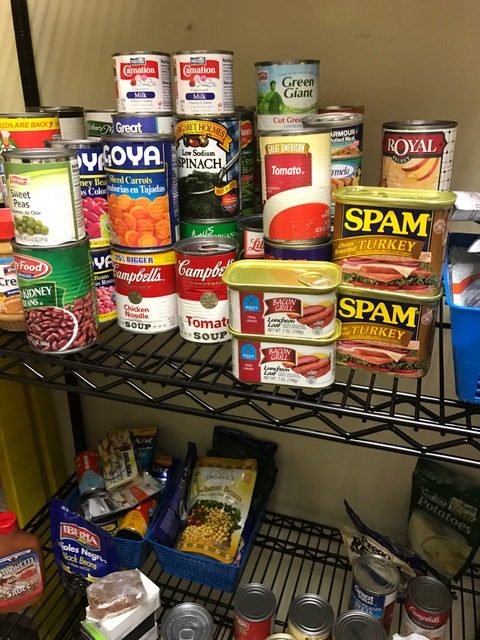
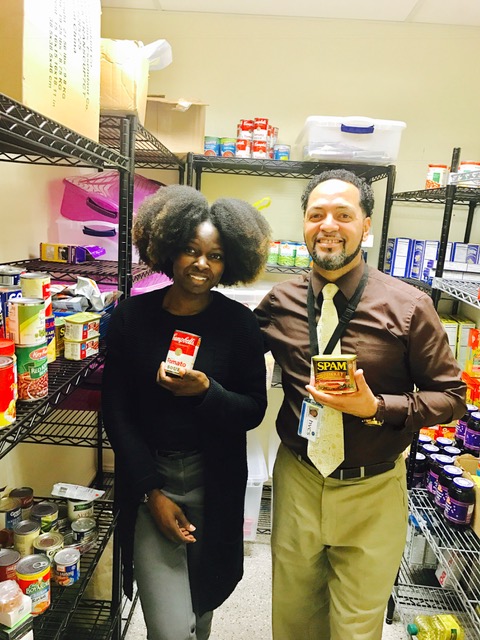 Special thanks to the members of the PACE (Prisoners’ AIDS Counseling & Education) program at Otisville for organizing a food drive for us in May! Members organized an AIDS Walk and asked fellow inmates to donate canned goods. Our Prison Services team attended the big event last month, and pictured here is Melissa and Steven with the results. Great job, PACE Otisville!
Special thanks to the members of the PACE (Prisoners’ AIDS Counseling & Education) program at Otisville for organizing a food drive for us in May! Members organized an AIDS Walk and asked fellow inmates to donate canned goods. Our Prison Services team attended the big event last month, and pictured here is Melissa and Steven with the results. Great job, PACE Otisville!
HVCS’ Food & Nutrition Programs Need Your Help
Wednesday, May 31st, 2017When you don’t eat right, you don’t feel right. And so it was for Terry.
Terry* would make the rounds of local food pantries and soup kitchens. It was how he survived. His ‘home base’ was a homeless shelter in Orange County – where our Nutrition Education and Outreach coordinators would see him. But he always declined their help.
He didn’t trust anyone enough to let them assist him. However, after talking to him for a year, Terry began to confide in our coordinator, Debbie. He opened up about his addiction issues, his lack of family support, and his illiteracy. All of the systems that our society has set up to help people like him had let him down.
Then one day he appeared in our Newburgh office. “All right,” he said. “I know you’re on my side. I need help.”
Debbie enrolled Terry into a nutrition access program in only two days.
“What are your goals?” Debbie asked.“I want a job,” Terry said. “I want a job so I can save money and get my own place, off the streets.”
Together, Debbie and Terry built a realistic plan to achieve that goal. After a few weeks and a referral to drug detox, Terry applied for and landed a job as a dishwasher in a local restaurant. Terry continued to receive nutritional assistance for a few months while he worked, and with our help he finally saved up enough money to rent a room of his own.
Terry went from being homeless and surviving on soup kitchens to being a fully contributing member of the Hudson Valley community.
And your support makes it possible. In fact, Hudson Valley Community Services has been supporting clients’ health with food and nutrition services for decades because of people like you. With your help we hand out over 10,000 food bags each year and feed nearly 1,100 people.
Donate today to keep our emergency food closets fully stocked.
We know you share our belief that a thriving Hudson Valley is made up of residents who are living their full potential: healthy, active and enjoying all the wonderful things that make this a great place to live. That’s why we connect anyone who needs temporary help getting enough food to all our available services.
But our food and nutrition programs are currently operating at a significant deficit because government grants aren’t able to meet the actual demand for food assistance in our area. In fact, three of our emergency food closets are sitting empty right now due to lack of funds, and we haven’t been able to purchase food from local food banks. Without direct support from caring people—like you—we’d be forced to reduce our services, hand out less food, and turn clients away from our emergency food closets.
Your contribution–of any amount–makes a difference.
It means we can keep our food and nutrition programs strong. It means people like Terry have a chance to create a meaningful life. So please continue to help us build healthy communities right here in the Hudson Valley. It goes far beyond keeping food on our pantry shelves. You can help fuel bodies, prevent disease, and turn lives around—and more people can live their full potential. Please give today.
Donations Needed for HIV Testing Programs
Thursday, May 25th, 2017HVCS isn’t afraid to have tough conversations. We shine a light on problems that thrive in the darkness. That’s only one of the tools we can use to bring new HIV infections to zero because of the support we have received from people like you. You have also inspired us to be the strongest of advocates in preventing HIV/AIDS. That is why we would like to share with you Louis’ story.
Louis is twenty-four, has one more year of grad school, identifies as gay and is, by all outward appearances, happy and successful. Yet sometimes he doesn’t feel like he’s got it all together—he copes with low self-esteem and anxiety. He has a supportive family but feels like he’s not attractive or smart enough and worries about the future. Sometimes in social situations he relies on “liquid courage”—he has a few drinks. He wants a long-term commitment (and, one day, a husband) but knows that as a young gay man he’s at higher risk for HIV infection. The things he did to feel better about himself, like going out and drinking, only made things worse. “It felt like the odds were stacked against me,” he said. “I felt pretty hopeless and scared.”
Until he came in for a free HIV test offered our INFORM program, which specializes in HIV prevention for men who have sex with men. The INFORM specialist told him that he could diminish his fear of contracting HIV by going on PrEP. The specialist connected him to a medical provider and worked out insurance coverage. He also referred Louis to a counselor to address his self esteem, supplied him with condoms, and discussed strategies for having a good time at parties without risking his health. “Now I always go with friends, and we make a pact to watch out for each other.” Louis feels more in control and less anxious about the future now that he’s equipped with more tools to stay healthy. By helping us to activate an entire network of supports—from his doctor to his friends to his therapist—you’re helping Louis stay as healthy as possible while staying true to his dreams and goals.
We know you share our belief that a thriving Hudson Valley is made up of residents who are living their full potential: healthy, active and enjoying all the wonderful things that make this a great place to live. But even with nearly forty years of studying how and why HIV is transmitted, Hudson Valley residents are still being infected with HIV. So we still need your help. Those who were at the highest risk decades ago are still at high risk because most people have a tough time talking about sexuality, desire, substance abuse, and race. This silence, combined with entrenched stigma against those with AIDS, allows HIV to spread through our communities—communities we need to stay healthy and strong if we’re to be a vibrant, colorful Hudson Valley.
What if Louis hadn’t come to us for a free HIV test? Though we believe that HIV testing is an opportunity to educate and engage people at high risk for HIV, government contracts don’t cover the full cost of offering those HIV tests for free. Our prevention programs are now operating in the red–and we may be forced to conduct fewer tests.
So we invite you to join us once again in keeping HIV prevention in the conversation. Your contribution means we can keep our HIV prevention programs strong. So please continue to help us build healthy communities right here in the Hudson Valley. Preventing the spread of HIV now means that more people can live their full potential.
Please give today.
